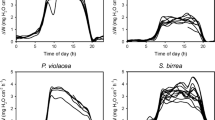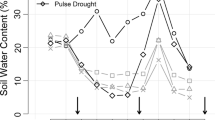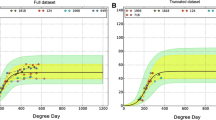Abstract
A method to evaluate the genetic control of plant response to increasing soil water deficit is proposed. A description of single tree transpiration behavior was obtained considering parameters independent from air and soil conditions. We removed environmental effects by using two approaches: the normalization of drought data to control (watered) plants and the fitting of a process model. We analyzed the transpiration of 475 4-year-old European beech seedlings, belonging to eight full-sib families. Approximately, one-third of the seedlings were kept in well-watered conditions while the others were exposed to drought for 14 days. Daily plant transpiration was estimated as the difference between two subsequent gravimetric measurements. A mechanistic model was fitted to transpiration data separately for each tree. In the model, the relationship of transpiration with vapor pressure deficit and soil water deficit of each tree is modulated by three parameters: maximum leaf conductance ( \(g_{\rm l}^M\)), maximum transpiration in well-watered soil conditions \((E_{\rm l}^{M_0})\) and a parameter describing stomatal sensitivity to soil water deficit (c). The model successfully fitted most single tree data and a distribution of estimates for the three parameters (\(g_{\rm l}^M\), \(E_{\rm l}^{M_0}\) and c) was obtained. Predicted transpiration values were in good agreement with observed data (R 2 = 0.86). The model approach produced parameters significantly correlated with those of the “normalization to control” approach. Estimated parameters vary considerably among trees, suggesting the presence of individual differences in stomatal behavior and response to drought. In spite of a large among tree (within family) variation, the among families component for \(g_{\rm l}^M\), \(E_{\rm l}^{M_0}\) and c explained 9.5, 3.3 and 0.1% of total parameters variation suggesting a significant genetic control of transpiration processes.





Similar content being viewed by others
References
Abrams MD (1994) Genotypic and phenotypic variation as stress adaptations in temperate tree species: a review of several case studies. Tree Physiol 14:833–842
Ackerly DD, Reich PB (1999) Convergence and correlations among leaf size and function in seed plants: a comparative test using independent contrasts. Am J Bot 86:1272–1281
Arntz AM, Delph LF (2001) Pattern and process: evidence for the evolution of photosynthetic traits in natural populations. Oecologia 127:455–467
Barton NH, Turelli M (1989) Evolutionary quantitative genetics: how little do we know. Annu Rev Genet 23:337–370
Bauerle WL, Post CJ, McLeod MF, Dudley JB, Toler JE (2002) Measurement and modeling of the transpiration of a temperate red maple container nursery. Agr For Met 114:45–57
Becker WA (1992) Manual of quantitative genetics. Academic Enterprises, Pullman, WA, USA
Bernetti G (1995) Selvicoltura speciale. UTET, Torino
Bernier PY, Bréda N, Granier A, Raulier F, Mathieu F (2002) Validation of a canopy gas exchange model and derivation of a soil water modifier for transpiration for sugar maple (Acer saccharum Marsh.) using sap flow density measurements. Forest Ecol Manag 163:185–196
Breuer L, Eckhardt K, Frede HG (2003) Plant parameter values for models in temperate climates. Ecol Model 169:237–293
Cavender-Bares J, Holbrook NM (2001) Hydraulic properties and freezing-induced cavitation in sympatric evergreen and deciduous oaks with contrasting habitats. Plant Cell Environ 24:1243–1256
Ceroni M, Leonardi S, Piovani P, Menozzi P (1997) Incrocio diallelico in faggio: obiettivi, metodologie, primi risultati. Monti e Boschi 48:46–51
Cochard H, Lemoine D, Dreyer E (1999) The effects of acclimation to sunlight on the xylem vulnerability to embolism in Fagus sylvatica L. Plant Cell Environ 22:101–108
Falconer DS (1989) Introduction to quantitative genetics. Longman, New York
Franks PJ, Cowan IR, Farquhar GD (1997) The apparent feedforward response of stomata to air vapour pressure deficit: information revealed by different experimental procedures with two rainforest trees. Plant Cell Environ 20:142–145
Geber MA, Dawson TE (1997) Genetic variation in stomatal and biochemical limitations to photosynthesis in the annual plant, Polygonum arenastrum. Oecologia 109:535–546
Geber MA, Griffen LR (2003) Inheritance and natural selection on functional traits. Int J Plant Sci 164:521–542
Gessler A, Rienks M, Rennenberg H (2000) NH3 and NO2 fluxes between beech trees and the atmosphere—correlation with climatic and physiological parameters. New Phytol 147:539–560
Granier A, Lousteau D (1994) Measuring and modelling the transpiration of a maritime pine canopy from sap-flow data. Agr For Met 71:61–71
Granier A, Biron P, Lemoine D (2000) Water balance, transpiration and canopy conductance in two beech stands. Agr For Met 100:291–308
Hanks RJ, Shawcroft RW (1965) An economical lysimeter for evapotranspiration studies. Agron J 57:634–636
IPCC (2001) Climate Change 2001. The scientific basis. In: Houghton JT, Ding Y, Nogua M, Griggs D, Vander Linden P, Maskell K (eds) Climate Change 2001. The scientific basis. Cambridge University Press, Cambridge, UK
Jarvis AJ, Davies WJ (1997) Whole plant ABA flux and the regulation of water loss in Cedrella odorosa. Plant Cell Environ 20:521–527
Jones HG (1992) Plants and microclimate. Cambridge University Press, New York
Levitt J (1980) Responses of plants to environmental stresses, vol I. Chilling, freezing and high temperature stresses, 2nd edn. Academic, New York
Lu P, Woo KC, Liu ZT (2002) Estimation of whole-plant transpiration of bananas using sap flow measurements. J Exp Bot 53:1771–1779
Medlyn BE, Barton CVM, Broadmeadow MSJ, Ceulemans R, De Angelis P, Forstreuter M, Freeman M, Jackson SB, Kellomaki S, Laitat E, Rey A, Roberntz P, Sigurdsson BD, Strassemeyer J, Wang K, Curtis PS, Jarvis PG (2001) Stomatal conductance of forest species after long-term exposure to elevated CO2 concentration: a synthesis. New Phytol 149:247–264
Meinzer FC, Grantz DA, Goldstein G, Saliendra NZ (1990) Leaf water relations and mainteinance of gas exchange in coffee cultivars grown in drying soil. Plant Physiol 94:1781–1787
Monteith JL (1995) A reinterpretation of stomatal responses to humidity. Plant Cell Environ 18:357–364
Nicotra AB, Chazdon RL, Schlichting CD (1997) Patterns of genotypic variation and phenotypic plasticity of light response in two tropical Piper (Piperaceae) species. Am J Bot 84:1542–1552
Pearcy RW, Schulze ED, Zimmermann R (1989) Measurements of transpiration and leaf conductance. In: Pearcy RW, Ehleringer JR, Mooney HA, Rundel PW (eds) Plant physiological ecology. Chapmann and Hall, London, pp 138–160
Peuke AD, Schraml C, Hartung W, Rennenberg H (2002) Identification of drought-sensitive beech ecotypes by physiological parameters. New Phytol 154:373–387
Ray JD, Sinclair TR (1998) The effect of pot size on growth and transpiration of maize and soybean during water deficit stress. J Exp Bot 49:1381–1386
R Development Core Team (2004) R: a language and environment for statistical computing. R Foundation for Statistical Computing, Vienna, Austria. 3-900051-00-3, http://www.R-project.org
Sackali MS, Ozturk M (2004) Eco-physiological behaviour of some mediterranean plants as suitable candidates for reclamation of degraded areas. J Arid Environ 57:1–13
Scalfi M, Troggio M, Piovani P, Leonardi S, Magnaschi G, Vendramin GG, Menozzi P (2004) A RAPD, AFLP and SSR linkage map, and QTL analysis in European beech (Fagus sylvatica L.). Theor Appl Genet 108:433–441
Acknowledgments
This research was supported by the European Union (QLRT-1999-01210, DYNABEECH) and the project M.U.R.S.T. COFIN2003 (Coordinator: Prof. Orazio Ciancio). We declare that the experiments comply with the current laws of Italy where the experiments were carried out. We wish to thank Marco Borghetti, Mariachiara Naldi and two anonymous reviewers for helpful comments on the manuscript.
Author information
Authors and Affiliations
Corresponding author
Additional information
Communicated by Hermann Heilmeier
Rights and permissions
About this article
Cite this article
Leonardi, S., Piovani, P., Magnani, F. et al. A simple general method to evaluate intra-specific transpiration parameters within and among seedling families. Oecologia 149, 185–193 (2006). https://doi.org/10.1007/s00442-006-0427-y
Received:
Accepted:
Published:
Issue Date:
DOI: https://doi.org/10.1007/s00442-006-0427-y




